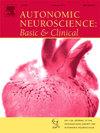Cardiac Vagal Nerve Activity During Exercise: New insights and future directions
IF 3.2
4区 医学
Q2 NEUROSCIENCES
引用次数: 0
Abstract
A new paradigm is emerging in which cardiac vagal nerve activity is maintained and increases during exercise. This paradigm challenges decades of studies that have quoted a withdrawal of cardiac vagal activity during exercise. Here, we outline the existing evidence for increased cardiac vagal activity. We also explain why previous indirect methods used to measure vagal activity might have indirectly led to incorrect conclusions about the role of the cardiac vagus during exercise. We will review evidence that vagal control of the sinoatrial node and the ventricles differs and how vagal neurotransmitters other than acetylcholine may regulate cardiac function during exercise. We will also suggest future directions for research to uncover how the cardiac vagus influences cardiac function and the mechanisms behind the increase in cardiac vagal nerve activity during exercise.
运动中的心脏迷走神经活动:新的见解和未来的方向
一种新的模式正在形成,即心脏迷走神经的活动在运动过程中得以维持并增加。这一范式对数十年来关于运动时心脏迷走神经活动减弱的研究提出了挑战。在此,我们概述了心脏迷走神经活动增加的现有证据。我们还解释了为什么以前用于测量迷走神经活动的间接方法可能会间接导致关于运动时心脏迷走神经作用的错误结论。我们将回顾迷走神经对中房结和心室内控制不同的证据,以及乙酰胆碱以外的迷走神经递质如何在运动中调节心脏功能。我们还将提出未来的研究方向,以揭示心脏迷走神经如何影响心脏功能以及运动时心脏迷走神经活动增加背后的机制。
本文章由计算机程序翻译,如有差异,请以英文原文为准。
求助全文
约1分钟内获得全文
求助全文
来源期刊
CiteScore
5.80
自引率
7.40%
发文量
83
审稿时长
66 days
期刊介绍:
This is an international journal with broad coverage of all aspects of the autonomic nervous system in man and animals. The main areas of interest include the innervation of blood vessels and viscera, autonomic ganglia, efferent and afferent autonomic pathways, and autonomic nuclei and pathways in the central nervous system.
The Editors will consider papers that deal with any aspect of the autonomic nervous system, including structure, physiology, pharmacology, biochemistry, development, evolution, ageing, behavioural aspects, integrative role and influence on emotional and physical states of the body. Interdisciplinary studies will be encouraged. Studies dealing with human pathology will be also welcome.

 求助内容:
求助内容: 应助结果提醒方式:
应助结果提醒方式:


